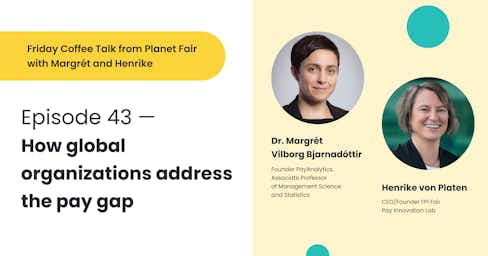Se préparer à la directive européenne sur la transparence salariale | Téléchargez gratuitement notre E-book

#43 - How are multinational companies addressing the pay gap?
In ensuring pay equity, global companies contend with the need to account for cultural values across countries. Read on to find out how to address cultural differences in compensation decisions.
Global companies face the additional hurdle of maintaining pay equity in each country.
In this week’s Friday Coffee Talk with Planet Fair, the topic of the day is cultural nuance, which raises an important issue for globally dispersed organizations:
In building out the qualities they value from employees, global organizations often find themselves struggling to create a model for making pay decisions that’s perfectly symmetrical and universal. Companies may have to embrace flexibility to accommodate for cultural differences, which brings us to the question:
When a company has branches across the world, regardless of the number of employees in each of those locations, how can they address the nuances of cultural value systems when determining fair pay from country to country, region to region?
Best practices for pay equity in a global organization
More often than not, Margrét notes, the differences in how pay decisions are made are subtle across locations—but they are always there. The root cause might be, for instance, the stipulations of union contracts. Pay philosophy may also differ: Some units may place more weight on performance in their analysis, while others might not account for it at all. The same goes for experience; some branches might value it highly, while it plays a secondary role in others.
According to Margrét, the end goal is to really “maximize [the] utility [of the model]. It’s not just about the measurement; it’s really about building a model that can support decision-making going forward so that (a) we close these gaps and (b) they do not come back”.
How exactly do multinational corporations do that?
To paint in broad strokes:
Global organizations take one of three approaches to fair compensation.
The first and perhaps most unusual path is to take a blanket approach.
Using this method, the company decides that certain fixed factors have to go into the model, and all branches then run their pay equity analyses using those factors. This practice is the least common of the three.
The primary benefit, however, is consistency. But consistency is also this model’s Achilles’ heel: It’s so broad that, perhaps, it “isn’t optimal for supporting the decision-making that needs to happen to close the pay gap.”
To address this drawback, some regions make a secondary model that’s more nuanced and conducive to closing gaps at the local level. But this policy, in turn, may lead to mismatch between the global and local model.
Which brings us to another approach:
The second is to embrace the best of both worlds.
Some companies choose to identify their principles–their ethos–and direct branches to include variables that align with those principles (A, B, C) in their model. They can then layer on additional factors (X, Y, Z) that the company has agreed are fair when applied consistently across the board. The result is global cohesion with cultural sensitivities. This is a much more common approach.
The third approach is really a free-for-all.
But Margret hasn’t seen this one implemented. Henrike, on the other hand, just encountered a group that was taking an “agile” approach to pay equity. What might agile pay equity look like?
Ready to learn more?
Watch the video to learn which approach may be right for your organization, plus more about how to address cultural differences in compensation decisions in a globally dispersed organization.
If you’re curious about how we can help, book a 1:1 with one of our specialists or start with our guides to regional requirements for pay equity.
Friday Coffee Talk from Planet Fair is a podcast/videocast series co-hosted by PayAnalytics founder Margrét Bjarnadóttir and Henrike Von Platen, founder and CEO of the FPI Fair Pay Innovation Lab in Berlin. It is available through all podcast platforms as well as on YouTube as a videocast.


